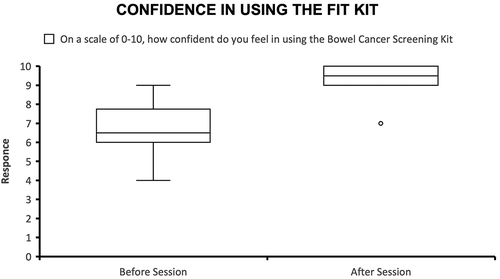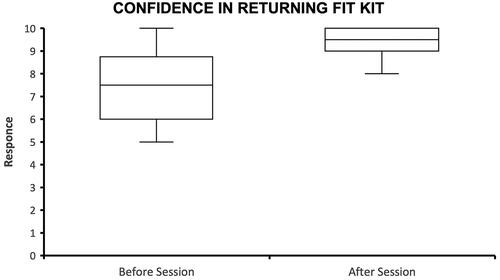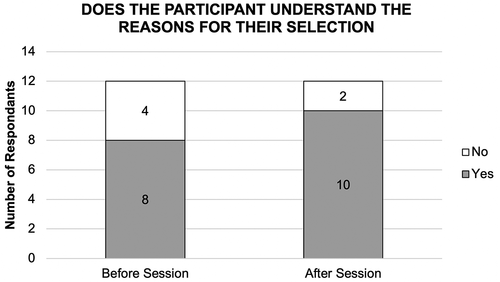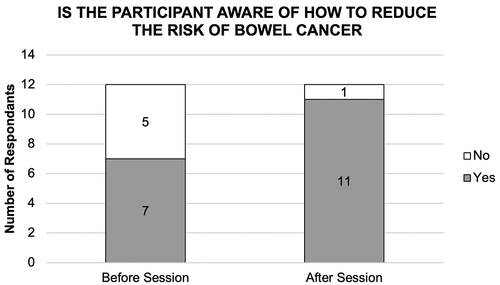ABSTRACT
In the United Kingdom, colorectal carcinoma (CRC) is the third most prevalent and second most lethal cancer, accounting for 1 in 10 cancer deaths. To address this health burden, the NHS implemented a national screening programme to detect traces of blood in the stool of those at highest risk of CRC – men and women aged over 60. Preliminary data showed that the screening programme reduced CRC death by 16% overall and 23% in those who had returned their kit, highlighting the importance of patient engagement. Worryingly, recent data has indicated that engagement with the screening programme has begun to decline. Many GP surgeries are failing to achieve the 75% quota set by the Quality and Outcomes Framework, with London performing least favourably within the UK. To address this, we set up an educational intervention at a London GP practice, targeting misconceptions and anxieties associated with bowel screening and CRC in general, to assess whether this would improve patients’ confidence in returning a stool sample as suggested by previous studies. Our results came to promising conclusions, but we remain cautious that our preliminary findings are subject to confounding influences which prevent conclusion of a causal relationship.
Context
Colorectal Carcinoma (CRC) is the third most common cancer worldwide, with a reported 1.8-million cases per annum [Citation1]. In the UK, CRC affects 1-in-14 men and 1-in-19 women and has increased in incidence over the last decade. Like most cancers, it is especially prevalent in the elderly, with those over 65 being thirty-times more likely to be diagnosed compared to 25–49 year-olds [Citation1]. In 2006 the NHS introduced the Bowel Cancer Screening Programme in hope of detecting CRC earlier and thus improving prognoses. Initial data supported the screening programme as studies cited a reduction in CRC mortality by 16% [Citation2]. Since 2006, the faecal immunochemical test (FIT) has replaced the previous guaiac faecal occult blood (gFOB) test due to its superior ‘positivity’ and higher uptake. However, there has been a steady decline in the uptake rate over the last 10 years with many GPs struggling to meet their 75% target set by the Quality and Outcomes Framework. Previous investigations have suggested that this is attributed to a fear of cancer diagnosis coupled with displeasures around handling faecal matter [Citation3]. Patient education has been shown to enhance overall engagement and equitable socioeconomic access to preventative health programmes in addition to an improved ability in interpreting screening results [Citation4].
Project aims
We aim to tackle the growing disengagement with bowel screening by implementing information drop-in sessions, the likes of which have been previously shown to positively impact health engagement behaviours.
Description
There are a multitude of factors which negatively impact engagement with bowel screening. Fear of a cancer diagnosis, sociocultural taboos of handling stool and ineffective communication regarding the benefits of early asymptomatic detection have all been identified as major disengaging factors [Citation3]. Addressing these barriers through active patient education is a high-efficacy, low-cost strategy to boost confidence in preventative health. We designed a one-hour information session aimed at 59-year-olds, those who would be the newest cohort to be invited for national screening, given that the age of selection is 60–74. The session was split into three overarching themes:
Introduction to CRC: Prevalence, Risk Factors and Associated Symptoms
Using the FIT: Clarification and Reassurance on Simplicity of Use.
Importance of Early Detection: Cancer Research UK (CRUK) leaflets and Q/A Session.
Outcome
To evaluate the efficacy of our intervention, we assessed ‘perceived confidence’ in the bowel screening programme using pre- and post-session self-evaluation questionnaires. Using the questionnaire responses, it was determined whether a relationship exists between educational exposure and bowel screening uptake.
Following a single session, the participants (n = 12) reported an increased confidence (measured via 0–10 Likert scale) in both ‘using’ and ‘returning’ the FIT by +41.7% and +29.9% respectively (p < 0.001; ). Additionally, a significantly higher proportion of participants agreed that they understood the reasons for their selection to provide a stool sample (+25.0%) and how they could actively reduce their risk of CRC (+57.1%) ().
Figure 1. Box and whisker plot showing an increase in perceived confidence in using the faecal immunochemical test (FIT) after intervention. box and whisker plot shows an increase in confidence from 6.58 to 9.33 (+ 41.7%) and that the reporting was more consistent (reduced interquartile range) in the post-intervention group

Figure 2. Box and whisker plot showing an increase in perceived confidence in returning the faecal immunochemical test (FIT) after intervention. An increase in average rated confidence from 7.25 to 9.42 (+ 29.9%) and that the reporting was more consistent (reduced interquartile range) in the post-intervention group

Figure 3. Column plot showing an increase in perceived understanding of selection criteria for the national bowel screening programme, after educational intervention. The number of participants who understood the selection criteria rose from 8 to 10 (+25%) after the intervention

Figure 4. Column plot showing an increased awareness of colorectal carcinoma risk factors, after educational intervention. The number of participants who were aware of bowel cancer risk factors rose from 7 to 11 (+57.1%) after the intervention

Ultimately, the bowel screening uptake rate for the entire GP register increased from 56.2% to 69.9% in the months succeeding our intervention.
Conclusion
CRC is the second most common cause of death due to cancer in the UK. After the gFOB test showed promising preliminary data from Europe, the NHS initiated a UK-wide bowel screening programme in 2006. Early studies highlighted the importance of engagement with the programme, given that the reduction in CRC mortality increased from 16% to 23% in those who actually participated compared to the general screening population irrespective of participation [Citation2].
Within the UK, London has the lowest CRC screening uptake, with ethnic background, likely linked to sociocultural taboos, and economic deprivation cited as precipitating factors [Citation5]. This finding was corroborated at a GP practice located in west London in a region with relatively high BAME population and low socioeconomic status. Despite our study being focused on this particular demographic, we envisage similar improvements to be achieved post-intervention in other social demographics.
To address the growing issue of preventative-healthcare disengagement, we implemented an educational intervention focusing on cultural taboos and misconceptions regarding CRC, with the aim of increasing participation with bowel screening.
Our results confirmed that active education significantly improved perceived confidence in ‘using’ and ‘returning’ the FIT and that more understood why they were specifically chosen to provide a sample. Given our sample size of 12, it is unlikely that the increased uptake from 56.2% to 69.9% observed for the entire practice was due to our intervention solely, but we remain optimistic that it played a role.
Although these preliminary findings are promising, the study was not covariate-controlled and thus doesn’t confirm a causal relationship between educational intervention and screening uptake nor does it guarantee reproducibility in different socioeconomic demographics. Concurrent health-promoting campaigns would need to be matched through a randomised-controlled-trial in order to establish causality and to determine which public-health interventions provides the most significant improvement in uptake.
Acknowledgments
We would like to thank the staff and patients at Canberra Old Oak Surgery for their help and participation in the study, as well as the primary care teaching fellows at Imperial College London for their educational mentorship, with particular thanks to Dr Dominique Forrest.
Disclosure statement
No potential conflict of interest was reported by the author(s).
References
- Rawla P, Sunkara T, Barsouk A. Epidemiology of colorectal cancer: incidence, mortality, survival, and risk factors.Overv gastroenterol [Przegląd gastroenterologiczny]. 2019;14(2):89–103.
- Logan RFA, Patnick J, Nickerson C, et al. Outcomes of the bowel cancer screening programme (BCSP) in england after the first 1 million tests. Gut. 2012;61(10):1439–1446.
- Palmer CK, Thomas MC, Von Wagner C, et al. Reasons for non-uptake and subsequent participation in the NHS bowel cancer screening programme: a qualitative study. Br J Cancer. 2014;110(7):1705–1711.
- Sabates R, Feinstein L. The role of education in the uptake of preventative health care: the case of cervical screening in britain. Soc Sci Med. 2006;62(12):2998–3010.
- Shankleman J, Massat NJ, Khagram L, et al. Evaluation of a service intervention to improve awareness and uptake of bowel cancer screening in ethnically-diverse areas. Br J Cancer. 2014;111(7):1440–1447.
